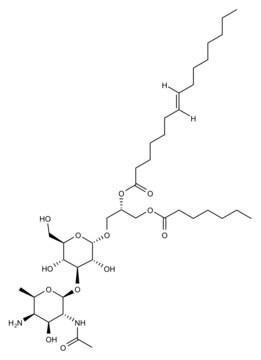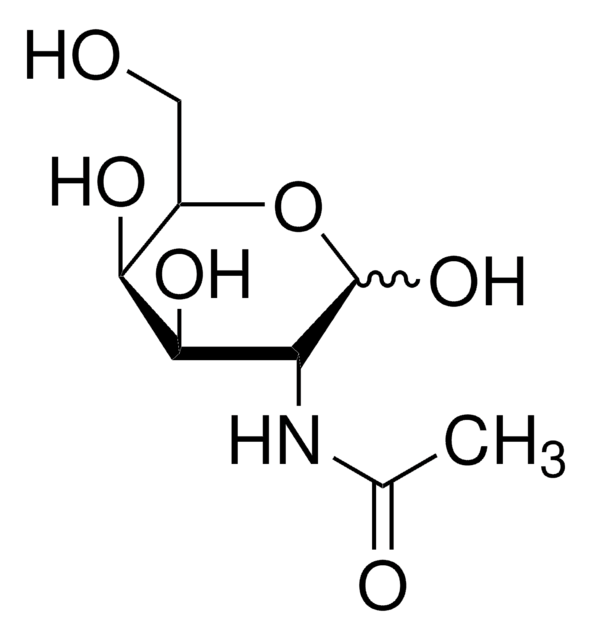77140
Peptidoglycan from Staphylococcus aureus
cell wall component
Sinónimos:
Peptidoglycan from S. aureus
Iniciar sesiónpara Ver la Fijación de precios por contrato y de la organización
About This Item
Productos recomendados
form
lyophilized powder
solubility
soluble, hazy to turbid, colorless to faintly yellow
storage temp.
−20°C
Categorías relacionadas
Application
Peptidoglycan from Staphylococcus aureus has been used:
- for the stimulation of lymphocytes: peptidoglycan activates the toll-like receptor 2 (TLR2), present in mammalian cells. It works as an antagonist of Poly (I:C)
- for g-type lysozyme stimulation by intraperitoneally inoculating it into sole specimens
- in phosphate buffer saline and injected into Labeo rohita fingerlings, to study its effect on nucleotide-binding oligomerization domain-2 (NOD-2) gene expression
Biochem/physiol Actions
The cell wall of gram positive bacteria is largely made up of peptidoglycan. It is composed of polysaccharide chains interlinked by peptide bridges. This peptidoglycan gives a certain rigidity to the cell wall and gives the cell mechanical strength. It is a surface molecule which is known to stimulate immune reactions including cytokine production to fever.
Packaging
Bottomless glass bottle. Contents are inside inserted fused cone.
Other Notes
Major component of the cell wall in gram positive organisms. Consists of a glycan backbone with alternating β 1-4 linked residues of N-acetyl-D-glucosamine and muramic acid. The immunological activities of bacterial peptidoglycanscitation; Peptidoglycan types of bacterial cell walls and their taxonomic implicationscitation; Antibody response to peptidoglycan during staphylococcal infectionscitation
Major component of the cell wall in gram positive organisms. Consists of a glycan backbone with alternating β 1-4 linked residues of N-acetyl-D-glucosamine and muramic acid. The immunological activities of bacterial peptidoglycans; Peptidoglycan types of bacterial cell walls and their taxonomic implications; Antibody response to peptidoglycan during staphylococcal infections
Storage Class
11 - Combustible Solids
wgk_germany
WGK 3
flash_point_f
Not applicable
flash_point_c
Not applicable
ppe
Eyeshields, Gloves, type N95 (US)
Elija entre una de las versiones más recientes:
¿Ya tiene este producto?
Encuentre la documentación para los productos que ha comprado recientemente en la Biblioteca de documentos.
Los clientes también vieron
L J Wheat et al.
The Journal of infectious diseases, 147(1), 16-22 (1983-01-01)
Levels of antibodies to peptidoglycan were measured by solid-phase radioimmunoassay in 76 patients with Staphylococcus aureus infections and 44 patients with infections caused by other bacteria. Levels of IgM antibodies to peptidoglycan were elevated in 24% of the patients with
The immunological activities of bacterial peptidoglycans.
D E Stewart-Tull
Annual review of microbiology, 34, 311-340 (1980-01-01)
Genomic characterization, phylogeny and gene regulation of g-type lysozyme in sole (Solea senegalensis)
Ponce M, et al.
Fish & Shellfish Immunology, 31(6), 925-937 (2011)
Xue Kong et al.
Frontiers in physiology, 9, 1476-1476 (2018-11-09)
Vesicomyidae clams are common species living in cold seeps, which incorporates symbiotic bacteria into their body maintaining endosymbiosis relationship. As members of pattern recognition receptor (PRR) family, peptidoglycan recognition proteins (PGRPs) recognize pathogen associated molecular patterns and play an important
A peptidoglycan recognition protein in innate immunity conserved from insects to humans
Kang D, et al.
Proceedings of the National Academy of Sciences of the USA, 95(17), 10078-10082 (1998)
Artículos
Peptidoglycans
Nuestro equipo de científicos tiene experiencia en todas las áreas de investigación: Ciencias de la vida, Ciencia de los materiales, Síntesis química, Cromatografía, Analítica y muchas otras.
Póngase en contacto con el Servicio técnico








